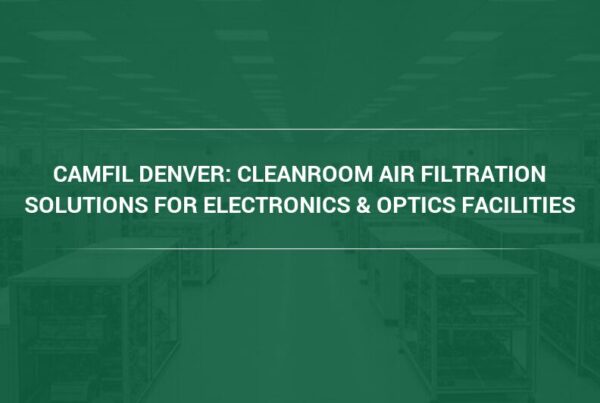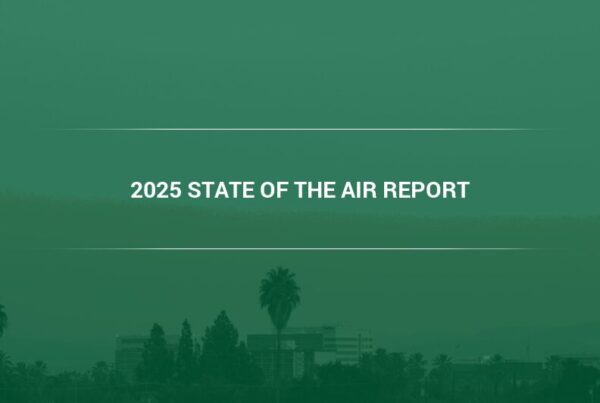Buying High Efficiency Air Filtration: Is it real or a myth? The rise of commercial air filtration comes alongside increased concerns over the problem of air pollution. In 2014, the World Health Organization (WHO) reported that around 7 million people around the world (or one in eight people) died as a result of exposure to polluted air.
It’s a finding that exceeds previous estimates by more than 200 percent, confirming suspicions that air pollution is now one of the world’s most pressing environmental health risks.
“Long-term exposure to ultrafine particles found in polluted air can increase your risk of respiratory and cardiovascular diseases,” notes Camfil USA’s Charlie Seyffer, Manager of Marketing & Technical Materials for commercial air filters and 37-year ASHRAE member and active committee participant. “Air pollution is a particularly serious problem for people living in urban areas, where there is often a high concentration of soot and smog particles, which in turn, increase the risk of death for these people.”
Particulate below PM2.5 (particulate matter less than 2.5 microns in size), becomes more harmful as they can now penetrate the alveoli of the lung and enter the walls of blood vessels. In other words, these microscopic contaminants can join the bloodstream in circulating through the body, reaching vital organs like the brain, heart, liver, and endocrine system, increasing the risk of disease development.
What is Air Pollution and How Do High Efficiency Air Purification Systems Eliminate It?
Simply put, high efficiency air purification systems are designed to remove the hazardous particles found in polluted air.
Air pollution basically refers to the release of particles into the air that is hazardous to human, animal, and plant health. Recognizing the dangers of uncontrolled air pollution, Congress passed the Clean Air Act of 1963, expanding on the provisions of the 1955 Air Pollution Control Act.
Although the CAA was not the first law pertaining to air pollution, it is arguably the most important, authorizing the United States Environmental Protection Agency (EPA) to regulate the emission of air pollutants from both stationary (e.g. factories, power plants, and industrial facilities) and mobile sources (e.g. cars, trucks, and farm equipment among others). Among several other things, the law orders the EPA to create National Ambient Air Quality Standards (NAAQS) to protect public health and welfare by setting the safe level of pollutants in the air.
“The majority of air pollution comes from the use and production of energy sources,” said Seyffer. “Burning fossil fuels, for example, releases all kinds of dangerous gases and chemical byproducts into the air.”
These gases and chemicals can cause a variety of diseases affecting our respiratory, endocrine, immune, and nervous systems among others. Carbon emissions in air pollution are also a contributing factor to climate change, which in turn, increases the growth of illness-causing allergens like mold (caused by damp conditions from extreme weather conditions and flooding) and pollen (caused by an extended warm and pollen production season).
Diseases Linked to Poor Outdoor and Indoor Air Quality
The same WHO study in 2014 broke down the variety of diseases and the corresponding percentage of fatalities caused by poor outdoor and indoor air quality
For fatalities caused by outdoor air pollution:
- 40 percent died from ischemic heart disease
- 40 percent from a stroke
- 11 percent from chronic obstructive pulmonary disease (COPD)
- six percent from lung cancer
- three percent from acute lower respiratory infections
For fatalities caused by indoor air pollution:
- 34 percent died from a stroke
- 26 percent from ischemic heart disease
- 22 percent from COPD
- 12 percent from acute lower respiratory infection in children
- six percent from lung cancer
Perhaps even more disturbing is how these diseases only scratch the surface of the health effects of air pollution. Note how the deaths mentioned above are only related to respiratory illnesses, which are clearly connected to air quality problems. But recent studies show less-obvious links between air pollution and seemingly unrelated diseases like diabetes.
For example, while diabetes is usually associated with obesity and sugar intake, an animal experiment conducted by researchers at Ohio State University in 2009 found a connection between the disease and air pollution. The researchers observed two groups of mice.
- One group was placed in an enclosure with clean, filtered air
- The other was placed in an enclosure with air containing fine particulate matter, but still at acceptable concentrations according to EPA standards.
Each group of mice spent six hours in respective enclosures each day for five days a week over the course of 128 weeks. The research team found that even if both groups of mice consumed the same amount of food, the mice living in polluted air developed characteristics resembling insulin resistance, while the mice exposed to clean air did not.
The Relationship Between Outdoor Air Pollution and HEPA Filter/Air Purifiers
The problem with air pollution and indoor air quality are that most people assume that merely shutting the doors and windows of homes and buildings will be enough to protect them from the polluted outdoor air. This approach, however, completely ignores the fact that the building’s heating, ventilation, and air-conditioning (HVAC) system needs to vent indoor air and draw in “fresh” air from the outside. This process is where commercial HEPA filters and air purifiers play a role.
Moreover, even if we assume your building is sealed from the elements, outside air can still penetrate the interiors through small cracks in the walls, floors, and ceilings of the structure.
This problem doesn’t even include the primary causes of poor indoor air quality:
- Incomplete or inefficient combustion of fuel from lighting, heating, and cooking
- Offgassing by machinery and equipment
- Fumes from building materials and cleaning products
How Do Air Filtration Systems Work?
Air filtration systems use fine sieves or media that filter particles from circulating air. As the air flows in and out of an HVAC unit, the air filter or purifier captures the airborne particles. The finer the sieve used in the filter, the more particles it will capture and remove. More importantly, the filter can trap microscopic particles found in chemical fumes, tobacco smoke, and automobile exhaust among others.
While there are many types of air filters on the market, the accepted benchmark has been set by High Efficiency Particulate Air (HEPA) filters. A true HEPA filter is designed to trap 99.97 percent of airborne particles down to 0.3 microns in size. A micron, which is equivalent to 1/25,400 of an inch, is the standard unit of measurement for particulate matter (PM).
For context, the filter that comes with your standard air conditioning unit can capture particles down to 10 microns, which are still visible to the naked eye if you were to look closely—think dust, dander, and other similar debris. Anything lower than 10 microns requires a microscope and a high efficiency filter to remove.
Which HEPA Air Filter Should You Get?
Given the known side effects of exposure to polluted air, a HEPA air filter is a must in any area burdened by poor outdoor air quality. But the question of which HEPA filter to get, however, ultimately boils down to your specific circumstances. We recommend asking these questions first.
- What kind of particulate matter am I trying to remove?
- What is the main source of indoor air pollutants?
- How large is the space requiring air filtration?
Remember that some HEPA filters are better than others. If you are interested in learning more about air purifiers and filtration systems by Camfil USA.
Media Contact:
Lynne Laake
Camfil USA Air Filters
T: 888.599.6620
F: Friend Camfil USA on Facebook
Y: Watch Camfil Videos on YouTube



